The extraordinary challenge of a school lunch in post-tsunami Fukushima
2012/06/06
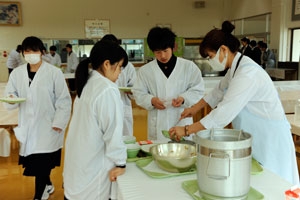
Authorities in Fukushima Prefecture have recently reclassified parts of the restricted zone around the nuclear plant to lift a ban on those areas where radiation levels are recorded at 20 millisieverts per year or less. Among the three communities where residents have been allowed back to their homes, is Kawauchi village. But only roughly 500 out of 3,000 inhabitants have gone back and the problems that Kawauchi faces in trying to revive itself may point to more general issues ahead. Francis Markus has been there.
(Photo: At this school in Kawauchi, only 14 out the 60 students have returned. Here, they are clearing away the dishes after lunch. It takes 4 or 5 hours each day to check the food for radiation. (c) Nobuyuki Kobayashi)
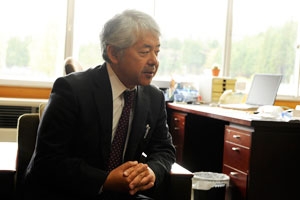
Gazing across the sandy expanse of the playground, the buildings of the middle school have a forlorn look and give the impression of being completely deserted – until through the window of one faraway building, we catch sight of a few human figures moving about.
“The students in there are just finishing their lunch,”explains the principal, Toshihiko Takahama, whom we find in his office at the front of the building.
They seem a very small group.“Before the disaster, we had 60 students, but only 14 have come back so far,” Mr. Takahama explains.
(Photo: Mr.Takahama, school principal of Kawauchi Junior High School (c) Nobuyuki Kobayashi )
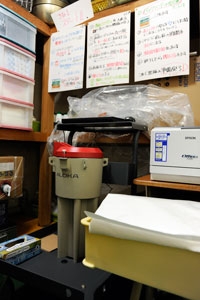
Extraordinary procedures
But even for such a tiny number, the procedures in place to make sure that the lunch they have just eaten is safe, are extraordinary.
Donning rubber boots, he escorts us to a little room at the side of the kitchen, where we see a cylindrical piece of equipment, hooked up to a laptop, for monitoring the radiation levels in the food.
“Each ingredient has to be checked – the potatoes take half an hour, the rice takes half an hour… altogether the process takes four or five hours each day.”
Similar machines have been provided by Japanese Red Cross Society, along with body scanners to measure radiation exposure in the prefectural capital Fukushima City.
(Photo: The machine with a red tab is a special equipment to check radioactive substances in food items.)
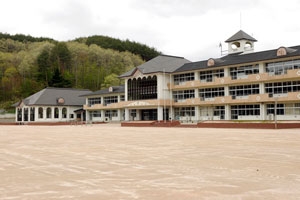
Food only one aspect
But food is just one aspect of the children’s safety, which Mr. Takahama and his staff have to worry about.
Since the disaster, he says they have put in place a system of emergency drills and alert messages, by which they would gather the children together and summon parents to fetch them in the event of a fresh disaster at the nuclear plant.
(Photo: Kawauchi Junior High School (c)Nobuyuki Kobayashi )
But that is not all. “Thanks to our vice-principal, who is a science teacher, we are also preparing plans for a sealed room concreted over where we can shelter in the event of another disaster.”
Is this mandated by the government, or is it the school’s own initiative, I ask him. “We are doing this ourselves.” But he thinks other schools would be wise to follow their example.
Advice of all kinds on what stance to take on the health risks and other issues is abundant but often contradictory.
“The local doctor told us that it was best to wait for a year or two before bringing my grandson back to the village,” says one woman in her 60’s, who has just come back for a temporary visit.
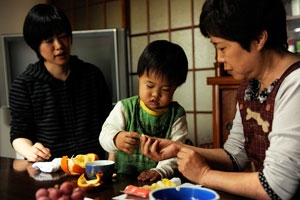
Doctors’views differ
She says doctors in surrounding communities in many cases had a different view.
The boy, a lively and stocky child, was born just a few days before the triple disaster. His mother’s home town is just a few kilometers from the Fukushima nuclear plant.
“They used to take us on school excursions to the plant. There wasn’t any preparation for something going wrong – it was all public relations.”
People around here are not disposed to take these matters likely any more.
(Photo: A family from Kawauchi village -- The boy (in the middle) was born a few days before the earthquake. (c)Nobuyuki Kobayashi )
They want more information and better preparedness – and that’s at the heart of a meeting in Tokyo in May to clarify what role the Red Cross Red Crescent can play in pushing for that, not just in Japan, but everywhere where nuclear plants are in operation.
-
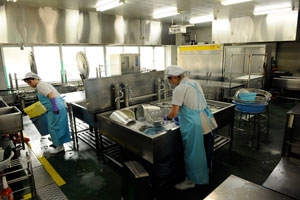
School kitchen staff are working hard to provide a well-balanced lunch to students.
-
-
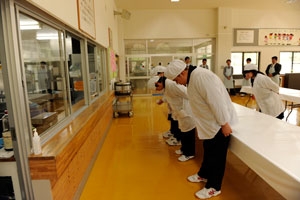
Before leaving a dining room, students make a line and express their thanks to kitchen staff.















